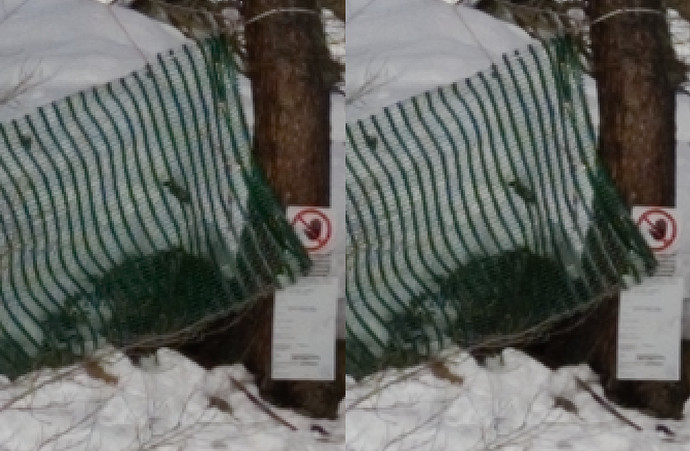@JackH I think what you see as colour bleeding are just the fine warp threads whose thickness is just below the resolution of the photo.

Good suggestion Sunhillow, though I am not sure because it looks like other temporary fences that I have seen around there and those are made of plastic.
Here are ART RCD, RT AMAZE and PSE2020: I think RT AMAZE has it mostly right, though with the most aliasing, see also around the red sign. So I would think that either during demosaicing or other filtering (e.g. chroma noise reduction) the other two smear things more.
y is more smeared so that would be ART?
Yeah, that’s what I mean, there is visibly more color ‘bleeding’ (for lack of a better word) than in RT’s version, though jpeg compression could be contributing to it. To recap, this is what I do to compare the renders, admittedly pushing things to the limit, but that’s what you guys are known for right? ![]()
Open raw image at default settings, white balance off the white sign, select crop and export 16-bit TIFF to CS5. In CS5 resize 400% using the Nearest Neighbor algorithm, save as PNG.
AMAZE: ART to the left, RT to the right. Admittedly small differences when viewing at 100%: in ART the snow through the fence appears more contaminated by green and the white around the hand by red.
At least in Germany they are mostly made of soft plastic coated fiber. I don’t know if cotton of plastic fiber. And between the vertical “bars” there are warp fibers which give can the snow behind the fence a green tint.
Here I found something that might look similar to your fence:
There’s certainly a visible difference. Can you share the settings you are using (arp and pp3)? Thanks!
Here they are:
https://drive.google.com/file/d/17DO0m7clVfFszMGQliKLHTNI0GnT2nGw/view?usp=sharing
https://drive.google.com/file/d/1NlARWnz-LGpBWVpz-4f5KmzH3PBzX_f9/view?usp=sharing
FYI, with respect to the other issue on opening TIFFs in PS, RT shows 600 dpi in the Crop tool.
Thanks. (BTW, you can just attach the arp/pp3 here if it’s more convenient).
You have different settings, that’s why you are seeing differences:
- In ART:
[Sharpening]
Enabled=true
Contrast=20
Method=rld
Radius=0.5
Amount=200
Threshold=20;80;2000;1200;
OnlyEdges=false
EdgedetectionRadius=1.8999999999999999
EdgeTolerance=1800
HalocontrolEnabled=false
HalocontrolAmount=85
DeconvRadius=0.62839657068252563
DeconvAmount=100
DeconvAutoRadius=true
DeconvCornerBoost=0
DeconvCornerLatitude=25
- In RT:
[PostDemosaicSharpening]
Enabled=true
Contrast=20
AutoContrast=false
AutoRadius=true
DeconvRadius=0.63
DeconvRadiusOffset=0
DeconvIterCheck=true
DeconvIterations=20
If you want to compare demosaicing, it’s better to turn off sharpening. I get identical results between ART and RT when doing that.
Thanks for looking into this Alberto. Are the two ‘Capture’ Sharpening algorithms different? The images above were produced at default settings (though I did increase RT’s threshold later to 20 after noticing ART’s).
Even after turning off sharpening in both I still see more bleeding in ART than RT. Barely noticeable and obviously nitpicking but probably due to some differences in the defaults elsewhere (wb, chroma noise or local contrast?).
On the other hand it’s obvious that the False Color Suppression is doing its job well, at the cost of some chromaticity shifts (easy to see when moving the slider by looking at the red in the hand sign).
They are essentially the same algorithm, but applied at different stages in the pipeline. Anyway, I would not use “false color suppression” to fix the moire’ here, but I’d rather apply some local smoothing. Something like this (attached arp):
DSC_2161.NEF.arp (13.0 KB)
They are different. They share some parts, but also some parts are different, as Alberto already mentioned.
@JackH Forgot to mention that I finally could download your raw file. Don’t know what caused the issue not being able to download it at first try ;-(
Yes, the smoothing does indeed get rid of the false color, nice one Alberto. Though the snow behind the fence now looks green 
The netting would probably cast a green shadow anyway…
The illuminant being the converter? 
Thanks Ingo. Makes sense since ART’s is faster, at least on Win 10 and my i7 (circa 2010).








